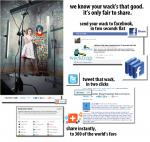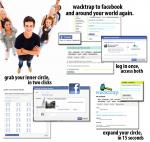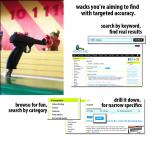What’s your story?
Share and find customer experiences
Connect with the people behind them
Wacktrap is
feedback made social
Trending Content
California SB 1453 Plans for Vehicle License Plates as Electronic Ads
by hearit
California State plans to use your car as a money-maker for it and the DMV--using SB 1453 with plans to turn your vehicle license plate into advertisements, in efforts to bring the state out of a 19 billion dollar hole. While California generates traffic ticket revenue related to driving distractions—it hypocritically plans to make more money off of introducing one.
California Bill SB 1453 pertaining to Digital License Plates and authored by Los Angeles State Senator Curren Price was unanimously approved by the Senate (25-0) in late May 2010. The main motive: to generate new revenue for the California state's budget which is currently about $19 billion in the read. Says Price: “State governments are facing unprecedented budget shortfalls, and are actively rethinking the use of existing state ASSETS to create new ongoing revenue opportunities”. It seems to be a nice way of saying that California state is desperate, willing to access whatever means possible--to make a buck.
Issued through Department of Motor Vehicles, it seems a vehicle license plate is an “ASSET” the state would now like to utilize to rake in some income.
California bill SB 1453—if approved—specifically instructs the Department of Motor Vehicles (DMV) to partner with companies in order to obtain research, development and implementation of a new technology to make standard license plates into basically a miniature computer screen. The part that’s being touted: all that research would come at no cost to the state of California—which, of course, isn’t as positive as it sounds—after all, why would there be a cost in that research, when there’s so much money to be made on those future ads the state wants to start pumping through those plates.
By 2013, California state seems to want an “end product”—a final report, detailing "real world" trials and data on how Digital Electronic License Plate (DELP) technology would deliver cost savings, workflow efficiencies and revenue generation. And to whom is that ad revenue generation slated to be headed? Ad revenue would to to the state of California, of course. Oh, and there is one other party standing to make money—the Department of Motor Vehicles (DMV).
So what does California State want to do with your vehicle license plates? California wants to replace current, physical plates with an electronic version: the plan is that Digital License Plate Ads would be displayed when cars or vehicles sit idle for four seconds for longer. The information that Amber alerts and traffic information could be shown--during emergencies (with no emergency defined)—is circulating; hopefully that will make people feel better that their traffic drive, and high registration fees on the vehicle that they pay for, will be—on some minute, unspecified, time period, POSSIBLY used for good. That concept does serve as a nice way to push through a Bill which specifically states that is designed to generate advertising revenue.
Since the display of neither Amber Alerts or traffic information serves to bring in any ad revenue, motorists can all take a stab at just how much usage digital license plates would truly experience for either one of those purposes.
All of this brings to the forefront another issue: driving distractions. If in fact the license plates were to transmit even Amber Alert or traffic information, how safe is it—during a traffic emergency—for motorists to be distracted while trying to read that “traffic information” or alert off of another driver’s license plate, even in stop-and-go traffic?
It is, of course, a bit ironic that the state of California is actually now generating revenue specifically related to traffic tickets and violations pertaining to driving distraction. Don’t have a hands-free you’re utilizing with that cell phone? You can be sure to be pulled over for that traffic offense —and, if you are issued a driving citation for lack of a hands-free (VC 23123), police officers are legally allowed to use the law as reason for a traffic stop, and to issue additional violations for the citation.
California drivers can be legally cited by police officers for lack of hands-free usage with cell phones or text messaging--so while the state of California is actively generating revenue pertaining to distracted driving, now the state wants to legally institute what is genuinely a specific distraction—the focus away from the act of driving itself.
There seems to be a bit of double-talk pertaining to the Bill and its intent.
"The idea is not to turn a motorist's vehicle into a mobile billboard, but rather to create a platform for motorists to show their support for existing good working organizations," Los Angeles State Senator Curren Price—author of the California Bill SB 1453—told the Associated Press.
Senator Curren’s wording regarding the SB 1453 Bill that he authored certainly seems strange, and more than a bit vague. The statement in fact seems a bit misleading—as it seems to directly conflict with the stated goal of the Bill itself, to create revenue. SB 1453’s goal is to create revenue for the state of California and the DMV—if the goal is revenue, then how is the “idea…to create a platform for motorists to show their support for existing good working organizations”? Are “existing good working organizations” companies that are willing to pay for ad space—that concept seems the only way that the Senator’s statement could possibly match wording for the Bill.
Seems there’s more than double-speak going on with the the Digital License Plates Bill:
1) SB 1453 actually REQUIRES the Department of Motor Vehicles (DMV) to research digital license plates as a means to generate new revenue for the California state's budget (a budget that is currently about $19 billion in the red)…however
2) The Bill’s author is now stating that "The idea [of Digital License Plates] is not to turn a motorist's vehicle into a mobile billboard, but rather to create a platform for motorists to show their support for existing good working organizations"—so, “good working organizations” or those organizations or companies willing to foot an advertising bill to the State of California and/or DMV (the goal of Bill SB 1453 is to to bring income to California, to help make up for its 19 billion dollar deficit in the red)
Also of interest is a piece of SB 1453 that includes “Restrictions that DMV may impose upon the message displayed on the digital electronic license plate”, “The control that a registered owner may have over the message displayed on the digital electronic license plate,” and “the control that a legal owner may have over the message displayed on the digital electronic license plate.”
Perhaps the most interesting phrase regarding research of SB 1453 is that regarding “Cost savings that may be realized by DMV through improved efficiency in the registration of vehicles, if any.”
The phrase could, of course, pertain to issuance and processing of stickers now required for physical—static, non-electronic—-license plates. But that phrasing leaves a lot of space—-for instance, couple with the State of California and DMV making any decision that the vehicle owner has no or minimal control over the “message” displayed on the electronic license plate, there’s nothing that seems to prohibit the state and DMV from prominently displaying lack of registration—-for easy sighting by police officers—in order to realize “cost savings that may be realized by DVM through improved efficiency in the registration of vehicles.”
SPEED UP YOUR ONLINE GROWTH
How To Wack
Take the Tour
Click on any image to start











